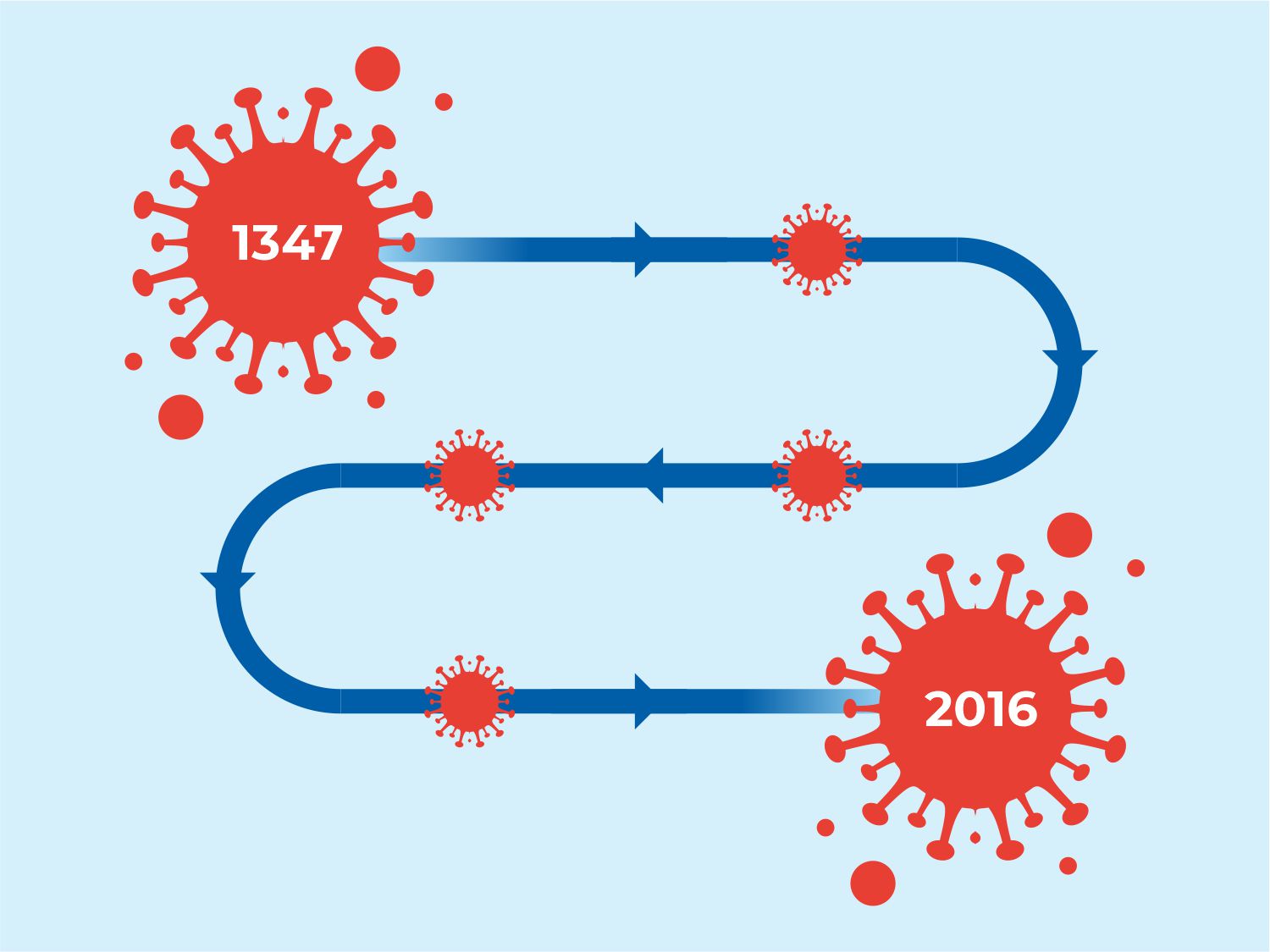
PANDEMICS
THROUGHOUT HISTORY
We have begun the new decade with a significant and complex challenge, as the entire world comes face-to-face with the Coronavirus pandemic. While this may form a new context for many nations and people, it is only the most recent of many pandemics that have challenges the human race throughout history. Each pandemic’s impact on health, livelihoods and other areas may have varied, however the all hold one defining similarity. They require a global response that prioritises human life and looks out for the vulnerable, similar to many aspects of natural disaster. As the AHA Centre explores its role within this new challenge, we take a look back over some of the key pandemics faced throughout history – and particularly in recent times.
Black Death / Bubonic Plague (1347-1351)
The bubonic plague is famous for its spread during a time that sea travel and ports were major links between countries and continents. Thought to have spread through rats and fleas, the plague (or Black Death as its more commonly known), moved across Europe, Africa and Asia killing anywhere between 75 to 200 million people over a number of years.
Smallpox (1520-1980)
The smallpox pandemic had a significant impact on native populations across the American continent, brought and spread by conquerors, adventurers and settlers into new and foreign lands. In the 1500’s the Aztecs experienced significant decimation, while it is also estimated that the disease killed 90% of native Americans in general. By the 1800’s the disease was still prevalent, and was killing around 400,000 people per year in Europe. As a result, the first ever vaccine created was to deal with smallpox, with its eradication finally complete by 1980.
Spanish Flu (1918-1919)
The smallpox pandemic had a significant impact on native populations across the American continent, brought and spread by conquerors, adventurers and settlers into new and foreign lands. In the 1500’s the Aztecs experienced significant decimation, while it is also estimated that the disease killed 90% of native Americans in general. By the 1800’s the disease was still prevalent, and was killing around 400,000 people per year in Europe. As a result, the first ever vaccine created was to deal with smallpox, with its eradication finally complete by 1980.
Asian Flu (1957-1958)
The smallpox pandemic had a significant impact on native populations across the American continent, brought and spread by conquerors, adventurers and settlers into new and foreign lands. In the 1500’s the Aztecs experienced significant decimation, while it is also estimated that the disease killed 90% of native Americans in general. By the 1800’s the disease was still prevalent, and was killing around 400,000 people per year in Europe. As a result, the first ever vaccine created was to deal with smallpox, with its eradication finally complete by 1980.
Hong Kong Flu (1968-1970)
Ten years after the Asian Flu came the Hong Kong Flu, with the initial outbreak in Hong Kong quickly moving into Singapore and Vietnam. Within a few months cases were detected across Asia, the Middle East, Europe, Australia and the United States, resulting in the deaths of over a million people worldwide. Even with a low death rate of around 0.5%, the pandemic did take the lives of around 500,000 people in Hong Kong itself, which was around 15% of the city’s population during the late 1960’s.
HIV AIDS (1981-Present)
HIV AIDS first appeared in Africa during 1976, and has gone on to form one of humankind’s greatest pandemic challenges for many decades. The disease has killed more than 36 million people since 1981, and has infected an estimated 5% of the total sub-Saharan African population. While awareness and treatments have grown and improved, and deaths and sickness have decreased with medicinal improvements, there is still no vaccine for the blood and sexually-transmitted disease, and it continues to be transmitted across the world.
Swine Flu (2009-2010)
The second pandemic from the H1N1 virus (the first being the Spanish Flu), Swine Flu resulted from a mix of flu strains during previous years. Killing a relatively smaller amount of people in comparison to other pandemics (200,000 deaths), there are studies that approximate the infection of between 700 million to 1.4 billion people across the world – which equates to up to 20% of the overall population at the time.
Ebola (2014-2016)
Having gone through a number of outbreaks since it was first discovered in 1976, Ebola became a serious pandemic in West Africa during 2014-2016. Spreading through contact with body fluids from humans and animals, this extremely deadly disease kills anywhere between 25-90% of people it infects, with an average of 50% death rate since its discovery. A vaccine was approved in 2019, with the hope that such advances can completely eradicate the deadly disease that killed over 11,300 during the 2014-16 pandemic.
Written by : William Shea | Source : https://jmvh.org and The Conversation

